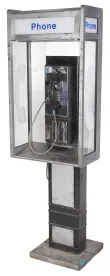Takeaway: An obviousness conclusion cannot be sustained by mere conclusory statements; instead, there must be some articulated reasoning with some rational underpinning to support the legal conclusion.
In its Final Written Decision, the Board found that Petitioner did not show by a preponderance of the evidence that the challenged claims are unpatentable. The ’243 patent “relates to “telephone communication systems in penal institutions or similar facilities.”
The Board first addressed claim construction under the broadest reasonable construction in light of the specification. The Board expressly analyzed two terms, “public telephone network” and “access attempt to said public telephone network.” With respect to “public telephone network,” Patent Owner proposed a construction, but Petitioner argued the term was well understood and Patent Owner’s proposal was unnecessarily limiting. The Board agreed with Petitioner that no express construction is needed.
Regarding the term “during each access attempt to said public telephone network by said potential caller,” the Board analyzed the term in the context of the entire claim, “specifically, which of the steps that follow recitation of the ‘during’ phrase must be performed ‘during each access attempt.’” The Board credited the following testimony of Patent Owner’s expert:
Simply put, it is my opinion that an “access attempt” is defined by a starting point (e.g., the beginning of the attempt) and the point at which the “attempt” either succeeds or fails. In this case, because the claim recites an “access attempt to said public telephone network”, the “attempt” will succeed or fail (and thus conclude) when the caller is granted access to, or ultimately denied access from, the public telephone network. The period in between these two events comprises some calling procedure in which the caller may be asked to provide certain information, dial the outgoing number, authenticate himself/herself, etc. The above construction is thus supported by this common sense approach.
Thus, the Board construed the term “‘during each access attempt to said public telephone network by said potential caller’ as encompassing the ‘prompting,’ first ‘recording,’ ‘matching,’ ‘comparing,’ and ‘granting’ steps.”
The Board then analyzed the prior art references, Susen and Gainsboro. The Board found Patent Owner’s arguments persuasive and held that Petitioner did not show that the prior art disclosed the “during each access attempt” limitation. In this regard, the Board found that the relied upon disclosure in the prior art involved steps that occurred prior to an access attempt, instead of the recited “during an access attempt.” Thus, the Board found that Susen does not disclose all the steps within the scope of the “during each access attempt” limitation.
Regarding the proposed combination of Susen and Gainsboro, the Board found that Petitioner’s reasoning to combine the references “is insufficient to support its contention.” To support an obviousness conclusion, a petitioner should provide a “clear articulation of reasons why the claimed invention would have been obvious,” and the conclusion “cannot be sustained by mere conclusory statements; instead, there must be some articulated reasoning with some rational underpinning to support the legal conclusion of obviousness.” After summarizing Petitioner’s assertions, the Board found that
[t]he cursory assertion that the prior-art references are drawn from the same broadly characterized field provides insufficient analysis concerning why and how a person of ordinary skill in the art would have modified or combined the prior art in the manner asserted, and inadequately articulates “reasoning with some rational underpinning to support the legal conclusion of obviousness.
The Board was also persuaded by Patent Owner’s expert testimony that the two references are not easily combined. Thus, the Board found Petitioner had not established the unpatentability of claims 1-6.
Securus Tech., Inc. v. Global Tel*Link Corp., IPR2015-00155
Paper 30: Final Written Decision
Dated: April 7, 2016
Patent: 7,853,243 B2
Before: Kevin F. Turner, Beverly M. Bunting, and Patrick M. Boucher
Written by: Boucher



 />i
/>i

